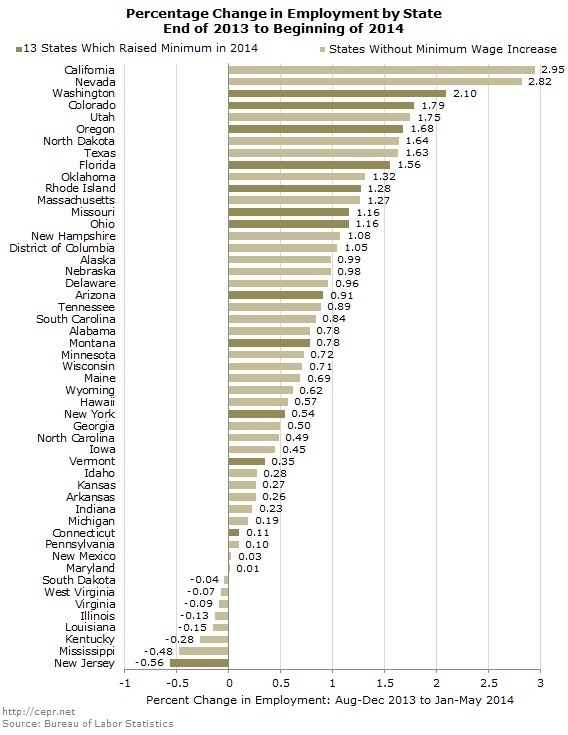June 30, 2014
The experience of the 13 states that increased their minimum wage on January 1st of this year might provide some guidance for what to expect here in Washington, DC when the city-wide minimum wage increases to $9.50 on July 1.
At the beginning of 2014, 13 states increased their minimum wage. Of these 13 states, four passed legislation raising their minimum wage (Connecticut, New Jersey, New York, and Rhode Island). In the other nine, their minimum wage automatically increased in line with inflation at the beginning of the year (Arizona, Colorado, Florida, Missouri, Montana, Ohio, Oregon, Vermont, and Washington state).
As CEPR noted in March and April posts, economists at Goldman Sachs conducted a simple evaluation of the impact of these state minimum-wage increases. GS compared the employment change between December and January in the 13 states where the minimum wage increased with the changes in the remainder of the states. The GS analysis found that the states where the minimum wage went up had faster employment growth than the states where the minimum wage remained at its 2013 level.
When we updated the GS analysis using additional employment data from the BLS, we saw the same pattern: employment growth was higher in states where the minimum wage went up. While this kind of simple exercise can’t establish causality, it does provide evidence against theoretical negative employment effects of minimum-wage increases.
In this post, we can now bring these figures up to date with the data from April and May.
The chart below shows the percentage change in employment for each state. The baseline is the average of the employment figures for the last five months of 2013 (August to December), which is measured against the average of the employment levels for the first five months of 2014 (January to May). As was the case with the earlier analyses by GS and CEPR, employment growth is still faster in states where the minimum wage went up.

Of the 13 states that increased their minimum wage in early 2014, all but one (New Jersey) are seeing employment gains. Furthermore, nine of the remaining 12 states are above the median for this period. The average change in employment for the 13 states that increased their minimum wage is +0.99% while the remaining states have an average employment change of +0.68%.
The experience of the 13 states that already increased their minimum wage in 2014 paints a very positive picture for Washington and its low-wage workers.
Note: All data taken from the BLS: “Regional and State Employment and Unemployment (Monthly),” Table 5, seasonally adjusted.






